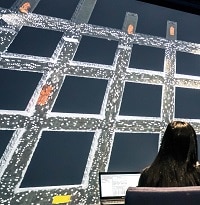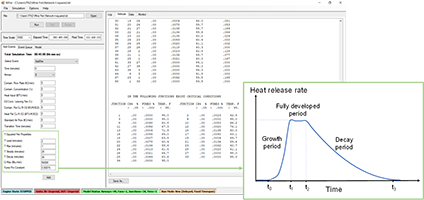MFIRE 4.0 Enhances Fire Modeling Capabilities
Summary

The MFIRE 4.0 software is now available from the National Institute for Occupational Safety and Health (NIOSH) to assist mine operators and researchers with modeling different types of fires that can occur in mines. MFIRE 4.0 substantially improves upon NIOSH’s mine fire simulation software MFIRE 3.0 by incorporating two time-dependent fire source models and a smoke rollback identification model. This software update will enable mine operators to better anticipate how to plan for and respond to a fire using more accurately modeled fire and ventilation behavior.
By Lihong Zhou, PhD, and Joseph Schall, MA
Background

A NIOSH researcher studying a virtual reality model of a mine ventilation system projected onto a large screen using data from MFIRE 4.0. Photo by NIOSH. (Click for larger image.)
MFIRE is widely accepted as a standard for assessing and predicting the impact of fire on a mine ventilation system and the spread of fire contaminants in underground mines. This transient-state mine fire simulation program provides a dynamic representation of a fire’s progress and serves as a valuable tool for mine fire emergency training, firefighting, and evacuation.
Since MFIRE’s original development by the Bureau of Mines and Michigan Technological University in the 1970s, several updates have been released over the years. In 2012, NIOSH completed a major redesign and restructuring of the program with the release of MFIRE 3.0. At that time, MFIRE’s outdated FORTRAN programming language was replaced with an object-oriented C++/C# language and packaged into a dynamic link library. However, the MFIRE 3.0 release made no attempt to change or improve the fire modeling algorithms inherited from its previous version, MFIRE 2.20, released in the 1990s. With important new technologies and innovations developed in the fire sciences since the 1990s, a need existed to update the fire models of MFIRE 3.0 to bring them to a new level of functionality.
Limitations of MFIRE 3.0
The accuracy of a mine fire simulation depends highly on successfully characterizing the fire source. MFIRE 3.0 users could choose from three types of fires (fixed-heat input fire, oxygen-rich fire, and fuel-rich fire) to model a given fire scenario. However, these three types of fire models cannot represent the changes of heat release rate over time (i.e., they are all time-independent). In reality, the development of a fire involves three stages: growth, fully developed, and decay. The heat release rate of a fire changes over time at each stage and is time-dependent. The time-independent fire models in MFIRE 3.0 could not simulate time-dependent fires.
Further, MFIRE 3.0 could not predict smoke rollbacks. Smoke rollback—occurring in mine entries when the buoyancy force generated by a fire overcomes the inertial forces of ventilation—can cause smoke migration upwind along the roof counter to the ventilation airflow. Smoke rollback can be a dangerous potential threat to miners and firefighters. By definition, it prevents firefighters from getting close enough to fight a fire effectively. It can also bring flame from the fire back onto firefighters when they operate from an upstream location. The ability to predict dangerous smoke rollback from fire in underground mines can help to ensure a successful and safe response by mine rescue teams.
Improvements Offered By MFIRE 4.0

Figure 1. A line graph (right) generated by entering parameters into MFIRE 4.0 (left) representing the heat release rate(HRR) for three stages of a time-dependent t-squared fire. Note an increasing HRR during the growth period (t0 to t1), a simplified constant HRR for the fully developed period (t1 to t2), and a declining HRR for the decay period (t2 to t3). (Click for larger image.)
Major improvements in MFIRE 4.0 over MFIRE 3.0 include the addition of a time-dependent fire source (referred to as a “t-squared fire”), which enables users to enter a time-dependent heat release rate for each of the three fire development stages. MFIRE users only need to specify the time period of each fire development stage and the maximum heat release rate, and MFIRE 4.0 generates a time-dependent heat release rate for the growth stage, fully developed stage, and decay stage. This feature follows the principle that the heat release rate is approximately proportional to the square of time (see Figure 1). In addition to the t-squared fire option, MFIRE 4.0 allows users to input a heat release rate curve from pre-saved material such as Excel data or a text file.
Finally, MFIRE 4.0 incorporates a well-validated mathematical model predicting the occurrence of smoke rollback in a fire entry. Thus, MFIRE 4.0 can predict smoke rollbacks and calculate their lengths. This feature can assist in many aspects of mine fire hazard mitigation and control, especially in emergency planning.
To Obtain the MFIRE Software
The MFIRE 4.0 program and the source code packet are available on the NIOSH Mining website.
For More Information
For more information on MFIRE 4.0, contact the NIOSH Mining Program (mining@cdc.gov).
DHHS (NIOSH) Publication No. 2021-109
DOI: https://www.cdc.gov/niosh/mining/works/coversheet2169.html
- The Critical Ventilation Velocity in Tunnel Fires - A Computer Simulation
- Development and Application of Reservoir Models and Artificial Neural Networks for Optimizing Ventilation Air Requirements in Development Mining of Coal Seams
- MFIRE - 4.0.2.0
- MFIRE Users Manual Version 2.20
- Modeling and Prediction of Ventilation Methane Emissions of U.S. Longwall Mines Using Supervised Artificial Neural Networks
- New Improvements to MFIRE to Enhance Fire Modeling Capabilities
- Safety Aspects of Mine Ventilation Through Technical Development and Training
- Specialized Fortran Computer Programming and Analysis Services to Upgrade Capability of MFIRE Program
- Study of Mine Fires and Mine Ventilation: Part I, Computer Simulation of Ventilation Systems Under the Influence of Mine Fires
- Technology News 564 - MFIRE 4.0 Enhances Fire Modeling Capabilities